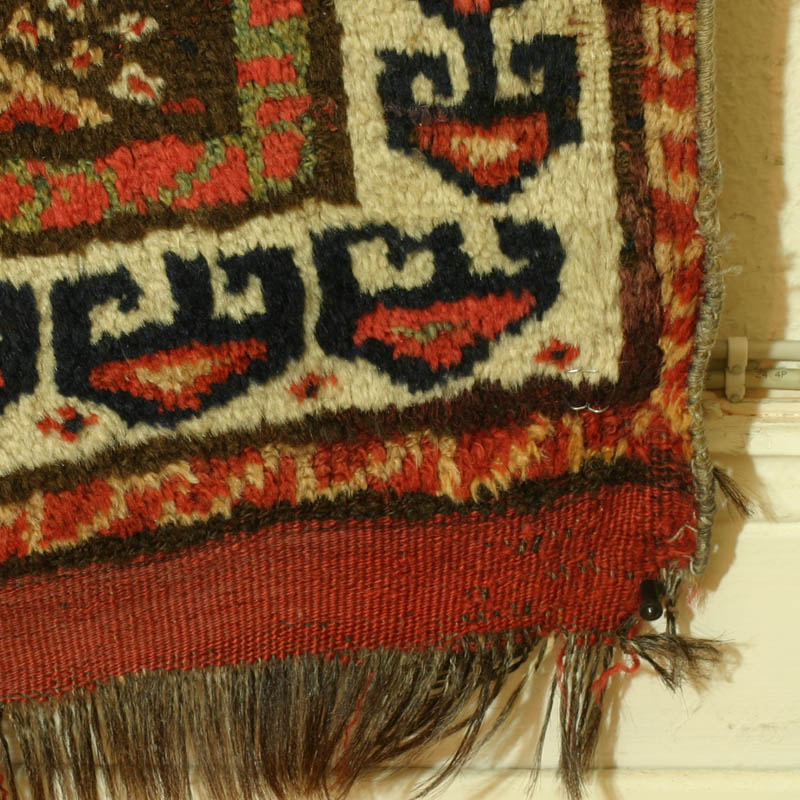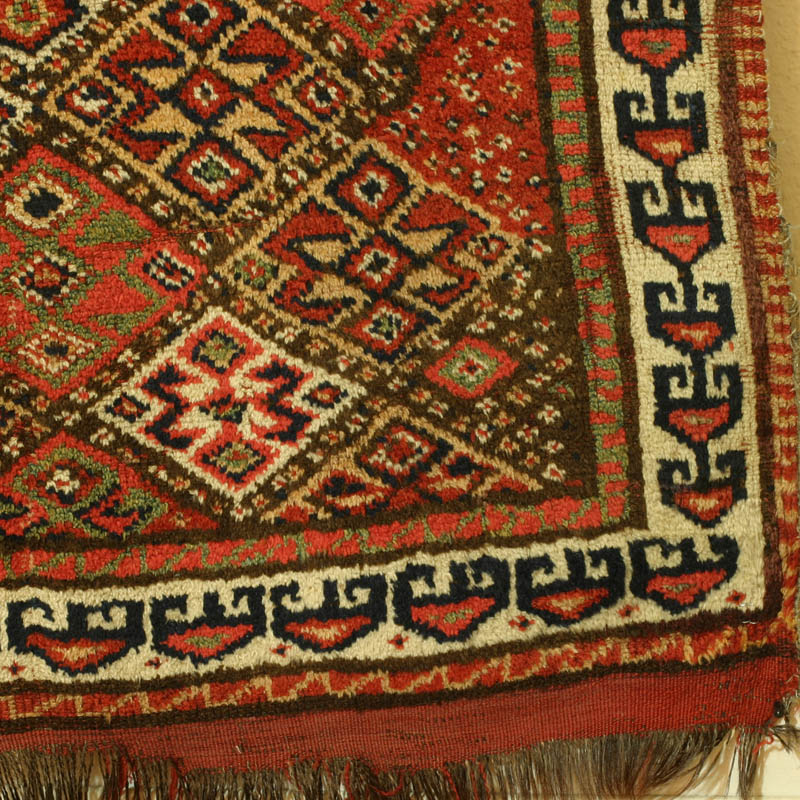Click on image to view at larger size.
There is also a very large view (1.3 MB).
In this charming old Kurdish rug, diagonal rows of diamond shapes form a fascinatingly irregular overall repeat pattern. Starting at the bottom with five half-diamond elements filling the width of the field, the weaver has managed a transition to just 4 1/2 elements further up. The adaptation of pattern during execution has led to various renderings of the connections between the narrow bands framing the diamonds (compare Figure 1).
The weaver's intention might have been to weave as regularly as she could manage; alternatively, a certain carelessness may have necessitated impromptu solutions which add a lot of liveliness to a repeat design that is always in danger of becoming a bit boring.
The repeat pattern might have been borrowed from the Baluch design repertoire, where rugs with diagonal rows of diamonds, slightly offset in the same way and usually showing rows in alternating colours, are not uncommon. Here, every other row alternates between diamonds with a red and yellow background.
The basic hooked diamond element is clearly derived from flatweave techniques and appears in similar form in various provenances: Baluch (Khorassan), Azeri, Jaff (i.e. western Persian) Kurds, anatolian flatweaves, etc. More often is shows the lateral hooks facing outwards (as in a typical diamond Jaff bag); here the lateral hooks face inwards, defining at the same time hooks of the background reaching inwards in a nice dense use of 'positive space' (compare Alexander) (compare Figure 2).
The many colourful filler motifs (five knot stars) used in the triangular shapes between diamond lattice and border and also as ornamentation of the brown bands forming the lattice create a very dense and animated overall impression.
The simple but effective border showing what I believe to be a stylised flower may be the most prominent trait of this rug. I cannot trace the type of border, but I believe I have seen it before, maybe on a Caucasian or Turkish rug (please tell me if you know of other examples).

Figure 1: Five types of connection of the bands forming the lattice: (a) stepwise offset; (b) only connecting via a small vertical bar; (c) direct continuation; (d) z-shaped dilation of the stepped offset; and (e) the formation of a bigger diamond-shaped lump at the connecting point

Figure 2: A much more regular rendering of the same design (without an arrangement in alternating diagonal stripes) in a Kurdish bag (probably executed in Soumak technique). Image reference: A bag offered on Rugrabbit by Patrick Pouler
The auction catalogue (Bonhams, London, Montpelier Rd) had this one down as "A Kurdish rug, West Persia". I think they got it wrong and this is an East Persian rug woven by Khorassan Kurds, but I am not sure. The statement by Jenny Housego about the structure of rugs of the "Kurds of Khurasan" (Tribal rugs, p.19) includes: "...wide red side finishes, the red plain weave skirts, and the red weft (...) a predominance of a characteristic golden yellow, red and ivory, and narrow borders in a simple zig zag."
A wide red selvedge is a distinct possibility since the sides are not original. The border is narrow, while not zig-zag - am I wrong to see an Anatolian influence? I think I have seen this border before, but I currently cannot locate the respective image of the rug in my books and catalogues. In a Baluch rug, perhaps?
Jenny Housego's description is consistent with Ford's (Oriental Carpet Design, p.195): "Neither the coarse, floppy structure of the Quchan rugs (woollen or goat-hair warps, two woollen wefts) nor their designs or colours remind us of the products of the main Kurdish weaving areas of Western Iran, but one frequently encounters striking similarities with Caucasian and Anatolian Kurdish styles." And, one could add, in many cases also Baluch or Turkmen elements like the coarse versions of the tribal guls, possibly presented through Baluch renderings of Turkmen stylistic elements (as in this Sistan Baluch rug with Tekke guls).
So here are some cues pointing into the Khorassan Kurd / Quchan direction; none of them alone may be sufficient to base the attribution on:
A limited, all-natural palette of fine and saturated dyes. Red dominates, two shades of brick-red matter, the lighter shade used as diamond background. A nice warm and saturated yellow and white, details in a nice mottled medium green, dark brown used in the fat lines separating main border and the primitive minor borders, and in the stripes of the lattice. dark blue used only for outlining of the diamond shapes.
An article on Khorassan Kurd living contions and rug production (in German) describes the typical Khorassan Kurd palette, including the frequent use of a yellow derived from larkspur (delphinium)—a plant not included in the 20 or so plants listed by Brüggemann & Böhmer as sources of yellow in Anatolian rugs:
"Alte Kordi Textilien besitzen frische, leuchtende Farben: zwei Schattierungen von Rot, ein helles und dunkles Blau, Weiss und Schwarz aus ungefärbter Wolle und als Besonderheit sehr viel Gelb und Grün. Chorasan hat viel Rittersporn (Delphinium), aus welchem der gelbe, gut färbende Farbstoff gewonnen wird."
Source: torba Report: Kordi, die Kurden Chorasans (PDF file)
The size is 6'11" x 5'1" (210 x 155 cm). An all-wool construction, symmetrical (Turkish) knots. Dark brown warps, possibly goat hair, two shots of red wool wefts. No warp depression, the weave is firm enough but not very tight, and coarse with h.20/10 and v.26/10 = 520 knots per square dm. (Converted to inches we have h.5,v.8 = ca. 40 kpsi). The handle is meaty and flexible. The bottom end has remnants of the red plain-weave skirt. The rug does not lie completely flat, though it's not too bad. Could be blocked to make it lie completely flat.
Both sides are not original; there is probably a loss of two knots (the outer brown line that follows the outer minor meander, border still visible at the bottom end) and the original selvage. Another selvage wrapped around two loosely twined cords has been attached which is in need of rewrapping / fixing (or one can leave it somewhat ragged as it is). Apart from that I can see no repairs or repiling. The top end also shows loss of a few lines of knots, in need of securing. The bottom plainweave skirt may have been somewhat longer than the longest remaining areas. It also needs to be secured. There are a few low / bare palm-sized areas, one close to the left border, a smaller one on the opposite side—not very obvious or disturbing. Apart from those areas, the pile is still quite good throughout (see images).




















